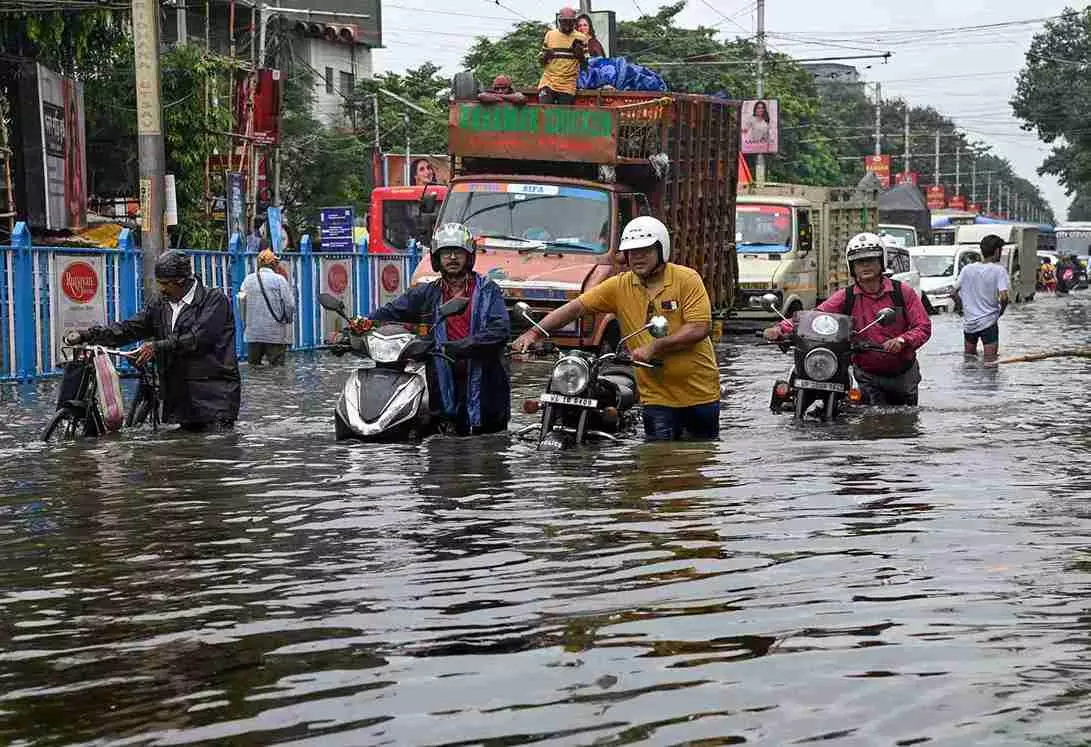
What caused Kolkata floods? A near-cloudburst, outdated drainage, ecological apathy
A whopping 252 mm rain in 7 hours, high tide, and outdated drainage cause massive waterlogging; CM blames DVC, while citizens point to KMC neglect

Most Kolkatans did not know what had hit the city on the intervening night of Monday (September 22) and Tuesday (September 23) — that is, until they woke up the next morning to find their neighbourhoods under varying depths of water, ranging from waist to ankle deep.
Only those living in the low-lying areas — especially in shanties and other modest single-storied dwellings — had started bearing the brunt of the flood from around 1 am itself. That was barely an hour after the downpour started, the kind of rain both Chief Minister Mamata Banerjee and Mayor Firhad Hakim claimed they had never seen before.
What made the pain worse was that the deluge came less than a week before Durga Puja — Bengal’s biggest festival — a time which people look forward to for an entire year not only for revelry but also for business.
As the Opposition BJP and angry people started blaming the government and the Kolkata Municipal Corporation (KMC) for the flooding — many joking on social media that not only one stretch but much of Kolkata’s underground railway was “underwater Metro” now — the chief minister blamed Damodar Valley Corporation (DVC) for poor dredging of the Farakka barrage, which she said caused the floods.
Also read: Kolkata floods: City struggles to return to normalcy; BJP attacks CM Mamata
So, what exactly caused the massive Kolkata floods that brought the city on its knees? It was a combination of several factors, some of which were beyond human control and some, the result of long-term neglect and ecological apathy. Here are some factors that caused Tuesday's Kolkata floods:
1. Record rainfall
The torrential rain that relentlessly lashed Kolkata for seven hours through Monday night and Tuesday morning reportedly came from a 7-km-tall column of cloud.
Exacerbated by a low-pressure system over the Bay of Bengal, this cloud column showered Kolkata with 251.4 mm of rain — nearly 20 per cent of the city’s yearly rainfall — in seven hours flat. This was the city’s heaviest downpour since 1986 and its sixth-highest single-day rainfall in the past 137 years.
The most intense spell reportedly came between 3 am and 4 am, when the city recorded 98 mm of rain — only 2 mm short of what would have been considered a cloudburst.
2. High tide in the Hooghly (Ganga)
Unfortunately for the city — and the KMC — it was also a time for high tide in the Hooghly. Even as the intense downpour kept flooding the city, the KMC’s drainage department had to shut the sluice gates to prevent the high tide from inundating the city further. So, the rainwater could not flow out even as it poured on beyond the strength of the colonial-era sewerage network to drain out.
As Mayor Firhad Hakim explained on Tuesday, “I have not seen such a downpour in my life. The canals and rivers are full of water, and every time water is drained out, more comes into the city. The situation may not improve until after tonight’s low tide.”
Also read: 10 dead in Kolkata rains; transport hit, Puja fervour dampened
3. Outdated drainage system
The city’s century-old drainage system relies largely on gravity, designed to empty rainwater into canals and sewers that, in turn, empty into the Hooghly. It is evidently inadequate to handle such intense rainfall.
Also, much of the system was designed for a smaller population and a different urban landscape, which is no longer fit for the mammoth population that Kolkata houses and the giant that the city has become. A 2024 research paper noted that the city’s drainage capacity is often exceeded during high-magnitude storms.
4. Kolkata’s bowl-shaped topography
Unfortunately for Kolkata, its natural terrain is bowl-shaped, with the city centre at a lower elevation than the outskirts. In this case, it turned into a bowl full of water, with no place for the stormwater to be pumped out. The existing pumping capacity also turned out to be insufficient for such a heavy downpour.
5. Plastic waste and blocked channels
Improper disposal of plastic waste is a major problem that clogs gullies and pumping systems, worsening drainage issues. Though the government has threatened to act against single-use thin plastic that is largely behind clogged drains, these have always made their way back to markets and neighbourhood shops. People continue to use them and litter the streets with such plastic, unmindful of the crisis they are bringing upon themselves.
Combined with a heavily silted sewer system and a lack of regular cleaning, the capacity of the outlet channels is often highly compromised, leaving the city at the mercy of nature. In areas like Salt Lake Sector V, the ongoing Metro construction has also clogged drainage lines, making matters worse.
Also read: Mamata Banerjee on Kolkata rains: 'Never seen such rainfall'
6. Unplanned urbanization and an ecological disaster
The city’s eastern wetlands worked as a natural drainage system for Kolkata’s stormwater. But over the past decades, those low-lying marshy lands and wetlands off the Eastern Metropolitan Bypass have been rampantly filled up — illegally, of course — for more and more construction. This has destroyed the city’s natural flood cushions. And the result of this neglect of the city’s natural flood buffer was for all to see on Tuesday.

